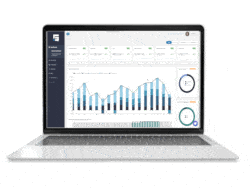One of the first things you will do in any accounting system is set up your chart of accounts. In today’s blog, we walk you through setting up a chart of accounts for your real estate management company.
A Quick Overview
Due to multiple requests by our readers, we created a few other articles that provide step-by-step instructions on setting up a chart of accounts for a real estate company, as well as a real estate company in QuickBooks Online and a commercial real estate company. These articles also contain step-by-step video tutorials and a free downloadable sample file.
The chart of accounts includes all the different types of accounts (assets, liabilities, equity, revenues, and expenses) used within your business. How you set this up is up to you as the owner. Think of the chart of accounts as the foundation for your financial record-keeping. Starting off on the right foot will save you thousands of dollars down the road, both by eliminating rework and having the ability to view your business performance clearly. A poorly constructed chart of accounts will not allow you to see your business operations effectively.
The Chart of Accounts has Several Main Functions:
- It creates a structure where every transaction has an associated account
- Provides a way to share information with bankers, accountants, etc.
- Helps with filing your taxes
- Finally, it guides you in decision-making
At the highest level, the chart of accounts includes assets, liabilities, equity, revenues, and expenses. No actual standard exists for a chart of accounts format. However, there are lots of examples. This article addresses the best way to set up a chart of accounts for an organization that owns and manages real estate.
Chart of Account Order
Although block numbering is not necessary, we find it most useful. We recommend setting your chart of accounts up in groups of 1000 so you have flexibility and room for growth.
| Number | Description | Purpose |
|---|---|---|
| 1000 - 1999 | Assets | Bank accounts and any real estate owned |
| 2000 - 2999 | Liabilities | Anything owed including mortgages and credit cards |
| 3000 - 3999 | Owner's Equity | This accounts for the financial contributions you have made towards the business |
| 4000 - 4999 | Revenues | Amount earned with rental properties |
| 5000 - 5999 | Cost of Goods & Services Sold (Expenses) | Directly related to the sale of your service (not typically used in a service business) |
| 6000 - 7999 | Expenses | Amount spent to run your real estate business, including maintenance of properties, advertising, etc. |
Detailed Chart of Accounts
Next, we will go into individual line items for the chart of accounts recommended by Quick Action Accounting. The example below is a company that owns and manages real estate. Give yourself room for growth to easily add additional accounts as you purchase more real estate or find additional items that require more granularity. As a note, you will want to keep your expenses in the miscellaneous area to a minimum.
(WARNING: This is a long table below, but it is useful content.)
| Account Number | Account Description | Type | Use |
|---|---|---|---|
| 1100 | Checking Account | Bank | Record all deposits or checks in this account |
| 1200 | Savings Account | Bank | Recording any savings deposits or withdrawals in this account |
| 1300 | Escrow | Bank | Some investors like to their insurance and taxes to be paid out of escrow which means the money is collected in advance and then paid out each month |
| 1400 | Rents Receivable | Accounts Receivable | These are unpaid or unapplied rents |
| 1500 | Dwelling | Fixed Asset | Separate out the value of the dwelling and the land. Each property will have a separate account |
| 1600 | Land | Fixed Asset | Separate out the value of the property and the land. Each land asset will have a separate account |
| 1700 | Property Improvements | Fixed Asset | Record all property improvements that are greater than $2500. Each property will have its own account to attribute any improvements to |
| 1800 | Accumulated Depreciated | Fixed Asset | Each property (not land) will have depreciation each year that needs to be recorded |
| 2500 | Credit Cards | Credit Card | All credit card transactions are recorded here |
| 2600 | Real Estate Mortgages | Long Term Liability | Each property will have its own account to record the mortgage |
| 3000 | Owner’s Equity | Equity | Any equity put into the business should be account for here |
| 4100 | Rental Income | Income | Each property will have a separate account where the income is noted |
| 4200 | Other Rental Income | Income | Each property will have a separate account where the other income is noted. This might include pet rent, appliance rents, garage rent, etc. Split out to the degree you want to be able to analyze your income from these different income streams |
| 4300 | Other Income | Income | You can include separate accounts for items such as interest earned |
| 6000 | Marketing Expense | Expense | Include additional accounts for items like dues and subscriptions, or advertising |
| 6100 | Professional Fees | Expense | Include separate accounts for Legal, accounting, consulting, memberships, or inspections |
| 7000 | Expenses | Expense | Include separate accounts for each expense type. We have included expense types to help as a foundation. We have also included helpful notes about some of the different expenses |
| 7100 | Homeowner’s Association (HOA) | Expense | Many neighborhoods (particularly those with condos) require owners to pay HOA fees |
| 7200 | Insurance | Expense | Insurance can be paid in a couple of ways: - Directly out of the owner’s account - Property owners frequently work with mortgage companies and have their insurance escrowed. Each month the portion of the mortgage payment that is associated with insurance, should be allocated to the property |
| 7300 | Taxes | Expense | Taxes can be paid a couple of ways: - Directly out of the owner’s account - Property owners frequently work with mortgage companies and have their taxes escrowed. Each month the portion of the mortgage payment that is associated with taxes, should be allocated to the property |
| 7400 | License and Permits | Expense | Cities frequently require owners to register their rentals |
| 7500 | Utilities | Expense | Includes water, electricity, and gas |
| 7600 | Mortgage Interest Payments | Expense | Each month a portion of the mortgage payment is associated with mortgage interest payments. That needs to be reflected here for the associated property |
| 7700 | Management Fees | Expense | If you use a property management company to help with management, the fee will be recorded here |
| 7800 | Cleaning & Maintenance | Expense | When a tenant moves out there are associated cleaning and maintenance activities |
| 7900 | Materials | Expense | This category is to reflect the purchase of lumber and other materials for the upkeep of a property |
| 8000 | Repairs | Expense | This is the labor recorded to make the actual repair |
| 8100 | Landscaping & Upkeep | Expense | Care of lawns, snow removal, and other landscaping activities belong in this category |
| 8200 | Education | Expense | Money spent on books, audiobooks, courses or other training materials to educate you on real estate can be captured here |
| 8300 | Travel & Parking | Expense | Capture all costs associated with out of town travel to look at real estate or attend conferences. Parking fees are also captured here |
| 8400 | Meals & Entertainment | Expense | Business meals, entertaining potential investors, business meetings, etc. |
| 8500 | Office Supplies | Expense | Any supplies purchased to help run your business - paper, folders, pens, paper clips, etc. |
| 8600 | Finance Charges | Expense | Interest charges from the bank or credit cards are recorded here |
| 8700 | Computer & Internet Expense | Expense | Equipment purchased to run your real estate business are collected here |
| 8800 | Miscellaneous | Expense | Catch-all for additional expenses that can’t be categorized. This should be used sparingly and if you see similar expense showing up here you |
| 9000 | Other Expenses | Expense | Another catch all category you may want to allocate certain expenses to |
| 9100 | Bank Fees | Expense | Could include overdraft fees, fees for checks, etc. |
(Congratulations! You made it! We love to hear your comments, so please leave one at the end of the blog.)
How to Track Separate Properties
We talked earlier about leaving room for growth. Give yourself room on your numbering so additional properties can be easily added. You want to be able to clearly see how the assets are performing individually on the asset, liability and expense side.
This is an example numbering schema for the dwelling account with multiple fixed assets.
| 1400 Dwelling | Fixed Asset | $1,310,000 |
|---|---|---|
| - 1401 - Property 1234 Holiday Drive | Fixed Asset | $110,000 |
| - 1402 - Property 4567 Raccoon Ridge | Fixed Asset | $550,000 |
| - 1403 - Property 7890 Lincoln Way | Fixed Asset | $650,000 |
The same model is used for expenses:
| 7700 Management Fees | Expense | $12,020 |
|---|---|---|
| - 7701 - 1234 Holiday Drive | Expense | $1,200 |
| - 7702 - 4567 Raccoon Ridge | Expense | $4,320 |
| - 7703 - 7890 Lincoln Way | Expense | $6,500 |
When to Use Classes
Separate expenses by property with the use of classes. Not every account will require you to break out the expenses with an individual line item. Classes give you the ability to split out the expenses so that you can see how each property is performing. This will be useful in the profit and loss detail report.
Common Mistakes When Setting Up a Chart of Accounts
Even seasoned real estate professionals can make setup mistakes that cause confusion or inaccurate reporting. Avoiding these pitfalls ensures your financials stay clean and consistent. Here are the most common errors — and how to fix them.
1. Overusing the “Miscellaneous” Category
It looks convenient to place small or vague transactions here, but it conceals valuable information.
Pro Tip: Consider opening a new account if your expenses are the same every time. This helps you better understand your expenses and maintains the integrity of your property accounting entries.
2. Not Separating Properties Clearly
Combining multiple properties in a single account can make it complicated to track performance or prepare accurate reports.
Pro Tip: Use distinct property management accounts for each property or set up sub-accounts. This is one of the most important property management accounting basics for real estate managers.
3. Ignoring Numbering Flexibility
A rigid numbering system limits your ability to grow.
Pro Tip: Use a block structure (e.g., 1000–1999 for assets, 2000–2999 for liabilities) to leave space for expansion. This method is common in every sample construction chart of accounts because it allows easy scalability.
4. Mixing Capital Improvements with Repairs
Merging capital improvements with maintenance can distort depreciation and tax calculations.
Pro Tip: Record these as separate real estate accounting entries. Improvements should be capitalized, while repairs belong under expenses.
5. Inconsistent Naming Conventions
If naming styles differ among accounts, reports become harder to read.
Pro Tip: Select a standard format such as [Property Name] – [Expense Type]. This is simple to follow and will help reduce errors when auditing real estate journal entries.
6. Neglecting Regular Reviews
A chart of accounts should evolve as your business grows.
Pro Tip: Review it annually to merge underused accounts and create new ones as needed. Consistency over time is key to strong real estate in accounting practices.
How to Integrate Your Chart of Accounts with Accounting and Property Management Software
Once your chart of accounts is established, connecting it to your software provides accuracy, automation, and transparent financial reporting across properties. This is where real estate and accounting efficiency intersect.
You can usually:
- Import your chart of accounts into your accounting software
- Allocate income and expense categories to each property
- Automate periodic real estate journal entries for rent, utilities, and management fees
While every system offers these features, STRATAFOLIO is designed with integration in mind. Built for real estate owners and managers, it helps you:
- Merge financial data across multiple entities and properties
- Simplify property management account tracking
- Reduce manual real estate accounting journal postings
- Experience timely and accurate portfolio performance
By consolidating your chart of accounts into STRATAFOLIO, you create an effective, scalable accounting structure that drives better decisions and sustainable growth.
Closing
The goal of any chart of accounts is to allow you to prepare good reports to manage your business effectively. This means you want consistency over time so you can easily compare property to property and year over year. This means that expenses must be categorized the same way each month.
Periodically monitor your chart of accounts to make sure they continue to make sense. This could mean expanding your accounts in certain areas so you have clarity on some expenses. Or, just as importantly, it could mean shrinking your accounts. If an account is not used much, you should consider rolling it into another. However, if there is a valid reason for keeping it separate, then do so. Either way, it is necessary to actively manage your chart of accounts.
Finally, good business management starts with good, clean accounting. The chart of accounts is the place to begin. Your accountant and your banker will both appreciate your organization.
If you’re looking for more specific information on smart accounting software for residential investors with rental properties, our friends at Stessa have a great platform.




